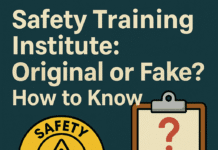
Safety Courses 2024: Navigating the Changing Landscape
I. Introduction
In the fast-paced world of today, the importance of safety courses cannot be overstated. As we step into 2024, the landscape of safety education is evolving, demanding a closer look at the courses that not only meet regulatory requirements but also ensure a secure working environment.
II. Types of Safety Courses
A. Workplace Safety
Workplace safety remains a top priority, with courses such as OSHA guidelines and hazard communication playing a crucial role. These not only keep employees safe but also ensure compliance with industry standards.
B. Health and Safety Courses
First aid training and CPR certification fall under the umbrella of health and safety courses. These not only empower individuals to respond effectively in emergencies but also contribute to a safer overall environment.
Safety courses in 2024 may cover a wide range of topics to ensure the well-being of individuals in various environments. The specific courses available can vary based on industry and location, but here are some common safety courses that might be relevant in 2024:- Occupational Health and Safety (OHS) Training:
- Overview of workplace hazards and prevention measures.
- Emergency response procedures.
- Health and safety regulations.
- First Aid and CPR Certification:
- Basic life-saving skills.
- Techniques for responding to emergencies.
- CPR for adults, children, and infants.
- Fire Safety and Prevention:
- Fire prevention strategies.
- Proper use of fire extinguishers.
- Evacuation procedures.
- Construction Safety Courses:
- Hazard recognition on construction sites.
- Proper use of personal protective equipment (PPE).
- Fall protection and scaffolding safety.
- Chemical and Hazardous Materials Safety:
- Handling and storage of hazardous substances.
- Emergency response to chemical spills.
- Understanding safety data sheets (SDS).
- Electrical Safety Training:
- Safe work practices with electrical equipment.
- Prevention of electrical shocks and fires.
- Lockout/tagout procedures.
- Driver Safety Courses:
- Defensive driving techniques.
- Adherence to traffic laws and regulations.
- Distracted driving prevention.
- Environmental Safety and Sustainability:
- Awareness of environmental regulations.
- Sustainable practices in the workplace.
- Pollution prevention.
- Workplace Ergonomics:
- Proper ergonomic practices to prevent musculoskeletal disorders.
- Designing workstations for optimal health.
- Stretching and exercise techniques for office workers.
- Security and Personal Safety:
- Threat awareness and prevention.
- Personal safety measures.
- Emergency response in case of security incidents.
These are just examples, and the actual courses available may vary. It's important for individuals to choose courses that align with their specific industry and job roles. Additionally, staying updated on the latest safety regulations and best practices is crucial in maintaining a safe and healthy working environment.III. Online vs. Traditional Classes
A. Flexibility and Convenience
In the digital age, the debate between online and traditional classes persists. The flexibility and convenience offered by online courses make them a popular choice, allowing learners to pace themselves according to their schedules.
B. Interactive Learning Platforms
The rise of interactive learning platforms adds a dynamic element to safety education. Virtual simulations and engaging content make online courses as effective, if not more, than traditional face-to-face classes.
IV. Accreditation and Certification
A. Recognized Institutions
Choosing courses from recognized institutions is paramount. These institutions not only provide quality education but also offer certifications that hold weight in the industry.
B. Industry-Specific Certifications
Certain industries require specialized certifications. These industry-specific courses ensure that employees are equipped with the knowledge and skills relevant to their particular work environment.
V. Benefits of Safety Courses
A. Reduced Accidents
Investing in safety courses correlates directly with a reduction in workplace accidents. Educated employees are more aware and cautious, creating a safer work environment.
B. Compliance with Regulations
Stringent regulations demand compliance. Safety courses ensure that businesses and individuals adhere to these regulations, avoiding legal complications.
C. Enhanced Workplace Productivity
A safe workplace is a productive workplace. Safety courses contribute to employee well-being, resulting in increased productivity and efficiency.
VII. Choosing the Right Course
A. Assessing Workplace Needs
Understanding the specific safety needs of a workplace is crucial. Tailoring safety courses to address these needs ensures maximum effectiveness.
B. Tailored Training Programs
Offering customized training programs for employees allows businesses to address unique challenges and foster a culture of safety.
VIII. Overcoming Common Challenges
A. Employee Resistance
Employee resistance to safety courses is not uncommon. Overcoming this challenge involves effective communication and emphasizing the personal and collective benefits.
B. Integration into Corporate Culture
Successfully integrating safety education into corporate culture requires commitment from leadership and a holistic approach that aligns with the company’s values.
Conclusion
In conclusion, safety courses in 2024 are not just a requirement but a strategic investment in the well-being of individuals and the success of businesses. As we navigate the changing landscape, the right safety education can make all the difference.
OSHA Safety Officer Certification
NEBOSH Safety Manager Requirements
IOSH Safety Manager Requirements
OSHA Safety Manager Requirements
NEBOSH Safety Engineer Requirements
FAQs
- Are online safety courses as effective as traditional ones?
- Online safety courses can be just as effective, if not more so, due to interactive learning platforms and technological advancements.
- How often should employees undergo safety training?
- Regular safety training is essential, with the frequency depending on industry standards, regulations, and workplace-specific needs.
- What industries benefit the most from specialized safety certifications?
- Industries such as construction, healthcare, and manufacturing benefit significantly from specialized safety certifications.
- How can businesses encourage employee participation in safety courses?
- Encouraging participation can be achieved through incentives, clear communication on the benefits, and integrating safety into the company culture.






















HSE Officer IOSHA OSHA